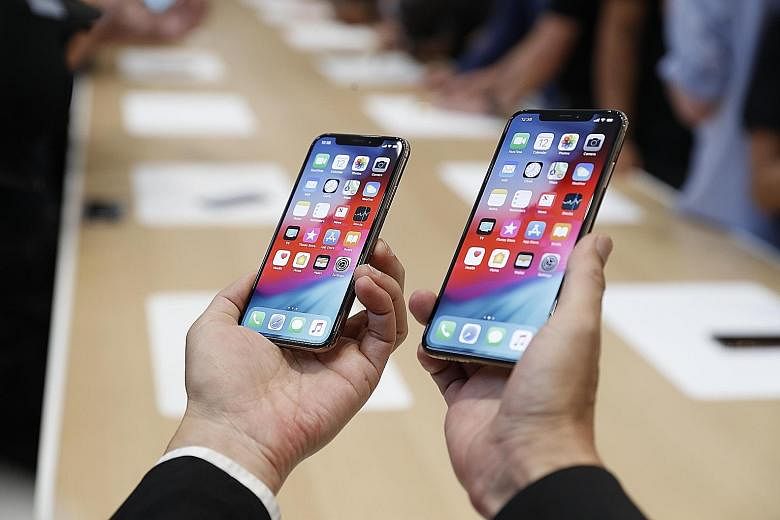Are the new iPhone XS and XS Max worth their hefty price tags? The Straits Times puts both to the test.
DESIGN
The iPhone XS and XS Max look just like their predecessor, the iPhone X. Not that this is a bad thing, considering that there are many phones in the market that mimic the iPhone X design.
Both use a surgical-grade stainless-steel structural band, which comes in three finishes of space-grey, silver and gold (version tested) to complement the front and back glass for a solid build. Both feel great.
While I am usually not one who likes gold in my gadgets, I find the colour subtle. It looks more bronze than gold to me and a gold iPhone XS or XS Max is something I would not mind carrying around.
Their water-resistance has increased to IP68, meaning they can withstand submersion in 2m-deep water for 30 minutes, compared with 1m for 30 minutes with the iPhone X. In addition, both phones are said to resist coffee, tea or soft drink spills.
You can use the iPhone X's case on the XS, but the opening for the camera will not align nicely with the rear dual-camera module. That is because the module is a bit larger than that of the iPhone X's.
DISPLAY
The major differences between the iPhone XS and XS Max are in the physical size and screen size. Both are 7.7mm thick, but the XS Max is 13.9mm taller and 6.5mm wider than the XS.
The iPhone XS retains the 5.8-inch display of its predecessor, while XS Max's 6.5-inch display is the largest ever on an iPhone. But both have the same pixel density of 458 pixels per inch.
Also, both displays have vivid colours and great contrast. High dynamic range (HDR) movies like Jurassic World: Fallen Kingdom (2018) and Wonder Woman (2017) look absolutely gorgeous on them. You can pick out the details even in the dark areas.
-
SPECS / IPHONE XS
-
PRICE: $1,649 (64GB), $1,889 (256GB, version tested), $2,199 (512GB)
PROCESSOR: A12 Bionic six-core chip with embedded neural engine
SCREEN: 5.8-inch Super Retina Oled (2,436 x 1,125 pixels)
CAMERAS: 12-megapixel rear dual cameras (wide-angle f/1.8; telephoto f/2.4), TrueDepth Camera (7-megapixel front-facing camera f/2.2)
WEIGHT: 177g
-
RATING
FEATURES: 5/5
DESIGN: 5/5
PERFORMANCE: 5/5
BATTERY LIFE: 4/5
VALUE FOR MONEY: 4/5
OVERALL: 5/5
-
IPHONE XS MAX
PRICE: $1,799 (64GB), $2,039 (256GB, version tested), $2,349 (512GB)
PROCESSOR: A12 Bionic six-core chip with embedded neural engine
SCREEN: 6.5-inch Super Retina Oled (2,688 x 1,242 pixels)
CAMERAS: 12-megapixel rear dual cameras (wide-angle f/1.8; telephoto f/2.4), TrueDepth Camera (7-megapixel front-facing camera f/2.2)
WEIGHT: 208g
-
RATING
FEATURES: 5/5
DESIGN: 5/5
PERFORMANCE: 5/5
BATTERY LIFE: 4/5
VALUE FOR MONEY: 4/5
OVERALL: 5/5

The audio from the bottom speakers and front-facing speakers has a stereo effect regardless of how you position the phone.
One downside, though, is that the audio jack to lightning adaptor is no longer included in the box.
SPEED
The new iPhones use Apple's new A12 Bionic processor, which features a six-core fusion architecture with two performance cores that are up to 15 per cent faster, and four efficiency cores that are 50 per cent more power-efficient than the A11 Bionic chip of the iPhone X.
In the GeekBench 4 benchmark tests, there is little to differentiate between the iPhone XS and XS Max. The former scored 4,788 points in the single-core test and 11,371 points in the multi-core test, while the latter scored 4,779 (single-core) and 11,366 (multi-core) points.
To compare, the iPhone X scored 4,200 (single-core) and 10,144 (multi-core) points. It might not sound much in terms of improvement, but even the impressive Samsung Galaxy Note9 scored 3,760 points (single-core) and 9,094 (multi-core) points.
Playing the games Fortnite and PUBG Mobile feels as smooth as playing them on my PC.
The embedded neural engine - used for machine learning or artificial intelligence in operations from photography to augmented reality (AR) - now features an eight-core design that allows it to do five trillion operations a second, compared with 600 billion operations a second with the A11 chip.
This allows AR apps to run much smoother and more seamlessly, which I can attest to after playing the golf-like AR game elemenTao, which lets players harnessfire, wind, water and earth to move a silver ball into a hole using the table as a landscape. I also trythe Ikea Place app and "placing" furniture in a room has never been easier.
CAMERA
If you look at just the specifications, you might think Apple has not upgraded the cameras.
But the image sensor has been upgraded with deeper pixels for improved image fidelity and larger pixels for better low-light sensitivity, even though the megapixel count remains the same.
Comparing photos of the same scenes taken with the iPhone X and both new iPhones, I find that images shot using the new iPhones have a higher dynamic range and are slightly sharper.
Even when taking photos with the sun behind a subject, the new iPhones keep the face bright while not overexposing the background too much. In night scenes, their photos exhibit less noise.
The biggest plus of the iPhone XS and XS Max is the ability to change the aperture size after you have taken a photo in Portrait mode. By changing the aperture size, you can adjust the background blur, or bokeh effect, accordingly.
While this feature might have been available in some smartphones before, the implementation here looks more natural in terms of the bokeh effect.
The improved TrueDepth camera also allows you to adjust aperture size after you take Portrait selfies - something you cannot do with the iPhone X.
On top of that, the Face ID in the new iPhones feels a split second faster compared with that in the iPhone X.
BATTERY LIFE
The iPhone X lasted eight hours and 40 minutes in the usual battery stress-test, in which a 720p video was looped at full brightness and full volume and with Wi-Fi switched on.
Put through the same test, the iPhone XS lasted nine hours and 30 minutes, while the XS Max lasted 10 hours and 20 minutes.
However, battery mileage depends on usage habits. I found both iPhones having about 50 per cent battery life left at the end of a work day, despite my regular monitoring of Facebook and Instagram updates, typing and sending messages on WhatsApp and Telegram, and constant checking of e-mail messages.
XS OR XS MAX?
The iPhone XS Max's 6.5-inch display might sound huge, but it has the same surface area as the 5.5-inch iPhone 8 Plus. Thus, it is not overwhelmingly huge. And I have to admit that watching movies, browsing the Internet and playing games on the larger XS Max is a much better experience, especially for those with increasing hyperopia like myself.
But the smaller-sized iPhone XS still makes it easier to use with one hand. So you have to choose between easier handling or better viewing experience.
I would pay extra for the bigger screen size and better battery life.
• Verdict: There is no doubt the iPhone XS and XS Max are the best smartphones Apple has released. And you will not go wrong with either iPhone if you are willing to pay for one.


